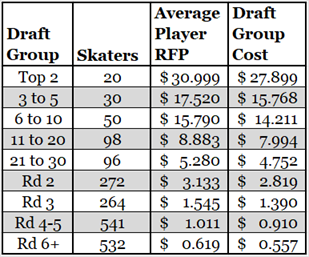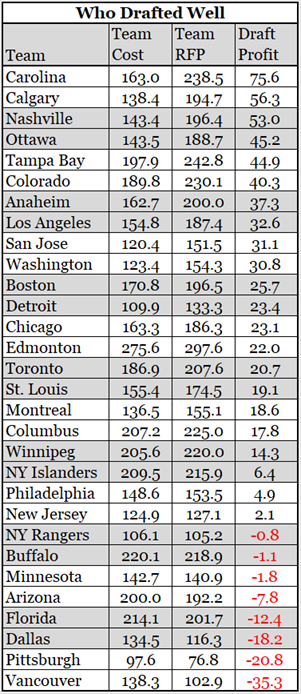In the article The Value of a Draft Pick, I explained a method that I used to convert a player’s Productivity Rating (PR-Score) into a dollar value that was called Return From Play (RFP). Draft pick slots were grouped together and the RFP of each player in the group over their first six post-draft seasons was added together. Dividing the total RFP of the group by the number of players in the group determined the values of draft picks. Or, very precisely, the values of ranges of draft picks.
In this article, RFP will be used to show which teams have done well at drafting, with respect to the draft picks they used. This will be done in a “return on investment” manner, so the first thing that needs be done is determining the investment for a team: what is a reasonable “cost” for a draft pick?
Team Cost for a Draft Pick

The table on the left is very similar to a table in The Value of a Draft Pick, with one extra column. Each row contains the name of a group of picks, the number of skaters drafted in that group, the average RFP for a player in that group (in millions of dollars) and the cost assigned to a team for picking a player in that group. The cost is the team’s investment, although the phrase “expected return” might actually be better wording.
The draft is a profitable event for teams: if they lost money or got worse because of the draft, there wouldn’t be a draft. In establishing the “cost” for a team to use a draft pick, I wanted a value that would be reasonable but would also result in most teams getting back more RFP than they invested. By setting the team cost at 90% of the average player RFP for a group, most teams will show a profit.
Ottawa (presently) has the seventh overall draft pick. Their “cost” for this pick will be (looks at table, finds row for picks 6 to 10, looks at fourth column in that row) $ 14,211,000. In terms of a drafted player, the one who comes closest to this expected return is Josh Morrissey, selected in 2013 with the #13 pick by Winnipeg: his RFP was $14,210,o00.
Study Details
Players who were drafted between 2007 and 2016 were used, because the analysis needs PR data (earliest season with PR data is 2007/2008) and six post-draft seasons (players drafted in 2017 have only had five post-draft seasons). PR does not work for goalies, so goalies will be excluded.
While NaturalStatTrick.com provides me with all the NHL player data I could want, its slight drawback is that it only provides me with data from NHL players. This study required information about players who never played in the NHL, so that I could assign teams their proper investment costs. I went to hockey-reference.com to get the list of which teams drafted in what slot, and whether the drafted player was a skater or a goalie. That data was invaluable!
For each drafted player, I noted which team made the pick and assigned the appropriate cost to that team (the team’s investment). Each player’s Return From Play for the first six post-draft seasons was calculated and was assigned to the drafting team (the team’s return), even if the player didn’t play all (or any) seasons for the drafting team. This article is about talent identification, not talent retention.
Total Team Return From Play
Edmonton has had the biggest returns from their drafted players at $297.6 million: they had lots of high draft picks that had good returns. Tampa Bay is second with $252.2 million. Carolina is third with $238.5 million.
The team with the least return from draftees is Pittsburgh at $76.8 million. The Pens are followed by Vancouver ($102.9 million) and the New York Rangers ($133.3 million).
Total Team Investment
While Edmonton had the biggest returns, they also had the biggest investment, thanks to having had four number 1 picks and a number 2 picks in the ten years we are looking at. Their investment cost is $275.6 million. Buffalo ($220.1 million) and Florida ($214.1 million) are distant second and thirds. Pittsburgh had the lowest investment ($97.6 million), followed by the Rangers ($106.1 million) and Detroit ($109.9 million).
Cutting to the Chase – Which Teams Did the Best
As noted several times in this article, this is a “return on investment” analysis. Although Edmonton had the biggest return from play, they also had the biggest investment, and are ranked fourteenth in terms of drafting.
The teams which did best are:
- Carolina – their draftees have a total RFP of $238.5 million, their picks cost $163.0 million, so they had a profit of $75.6 million.
- Calgary – RFP $194.7 million; cost $138.4 million; profit $56.3 million
- Nashville – RFP $196.4 million; cost $143.4 million; profit $53.0 million
- Ottawa – RFP $188.7 million; cost $143.5 million; profit $45.2 million
- Tampa Bay – RFP $242.8 million; cost $197.9 million; profit $44.9 million
Stapled To The Bench does not want to pick on teams or players (except for guys like Colton Orr), but we have to look at the bottom of this list. The teams that got the least return on their drafting investments are:
- Arizona – RFP $192.2 million; cost $200.0 million; loss $7.8 million
- Florida – RFP $201.7 million; cost $214.1 million; loss $12.4 million
- Dallas – RFP $116.3 million; cost $134.5 million; loss $18.2 million
- Pittsburgh – RFP $76.8 million; cost $97.6 million; loss $20.8 million
- Vancouver – RFP $102.9 million; cost $138.3 million; loss $35.3 million
An appendix will have a table with each team’s cost, their return from play and their profit or loss. A word of warning: it is a wall of numbers.
Summary
The return from play values were credited to the drafting team rather than the team the players played for, because I wanted to see which teams did the best job of identifying talent. The biggest return from play for a Calgary draftee was created by Adam Fox, who has played for only the New York Rangers in the NHL.
Of the top five teams with the best returns from play, only Tampa Bay has won a Stanley Cup. But they won the last two and are heading into the third round in this year’s playoffs as this article is being written.
It would take more detailed research than I feel like doing to prove that Florida and Arizona had poor results due to terrible drafting decisions. What the data doesn’t show is why players didn’t do as well as expected, and for every player that didn’t do well, there could be a different reason. The two biggest reasons would be injuries (which happen and cannot be held against the player or the team) and faulty decision making (which happens and probably can be held against the team).
Appendix A – Detailed Draft Returns Table

The ten players who provided the biggest return for their team’s investment include two each from Carolina and Edmonton.
Edmonton’s duo are Connor McDavid and Leon Draisaitl, and they are the only players in this big-return group that were drafted in the top five picks. David Pastrnak (#25 pick, Boston) and John Carlson (#27 pick, Washington) are the only other players in the group that were drafted in the first round.
Carolina’s pair are Sebastian Aho and Justin Faulk. Aho produced the biggest return for his team’s investment in this study. Aho’s cost was $2.8 million and his RFP was $32.4 million.
Vancouver’s three best picks are Brock Boeser, Bo Horvat and Ben Hutton (2012, #147 pick). Their biggest albatross was Olli Juolevi, the 2016 #5 pick. He has played a handful of games with an RFP of $507,000, while the team’s cost for him was $15.8 million.
The player who cost his drafting team the most was Nail Yakupov (Edmonton’s #1 pick in 2012). His RFP of $11.0 million fell just a bit short of his draft cost of $27.9 million (loss of $16.9 million for Edmonton).
Griffin Reinhart was another significant draft failure, having been picked #4 overall and producing an RFP of $361,000. Reinhart was also drafted in 2012. Did Reinhart and Yakupov cause the 2012 class to be the worst draft class since 2007? You can find out by reading my third draft article: Rating the Draft Classes.
